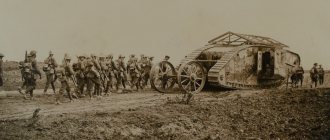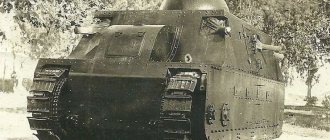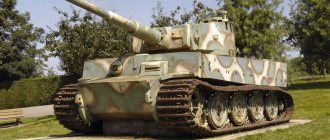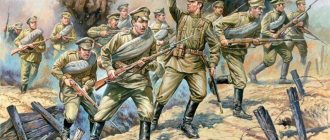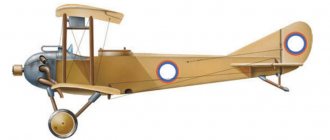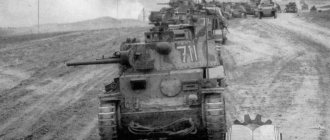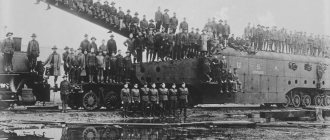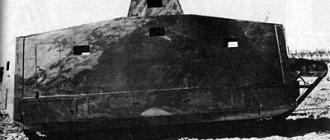Tanks - new progressive weapons for battle
The first tanks of the First World War appeared in 1916. This technical result was achieved by English and French engineers. Before talking about their characteristics, we need to understand why the first tanks appeared in the First World War. The fighting began violently, but the activity continued for literally a month. After this, the battles began to be mainly of a positional nature. This development of events did not suit any of the warring parties. The methods of warfare that existed at that time, as well as military equipment, did not allow us to solve the problem of breaking through the front. It was necessary to look for a radically new solution to the problem.
The military leadership of England (and, in general, France) was wary of engineers’ initiatives to build an armored vehicle on wheels or on tracks, but over time, the generals realized the need to increase the level of technical equipment of their armies.
Children's book
War Horse is a war drama directed by Steven Spielberg based on the novel of the same name by Michael Morpurgo.
It tells about the friendship between the boy Albert and the stallion Joey. Unwittingly, they make a journey full of tragic events, ending up from a picturesque village to the trenches in northern France, where the outcome of the war was decided. Author: Laurie Herber, Carla Bleiker, Ella Volodina
"Cannon Fodder" '14
Watch video 06:08
British tanks of the First World War
During the war, British engineers created several models of armored vehicles. The first option was called "Mark-1". The “baptism of fire” took place on September 15, 1916 during the Battle of the Somme. The first tanks of the First World War were still technically “damp”. According to the plan, it was necessary to use 49 tanks in battle. Due to technical problems, 17 tanks were unable to take part in the battle. Of the 32 tanks, 9 were able to break through the German defenses. After the first battle, problems that needed to be eliminated immediately became visible:
— The armor should be stronger. The metal of the Mark-1 tank could withstand bullets and shell fragments, but in the event of a direct hit by a shell on the vehicle, the crew was doomed.
— Lack of an engine room separated from the “salon.” While driving, the temperature in the tank was 50 degrees, all exhaust gases also went into the cabin.
What could this tank do? In principle, there is still a little to do: overcome wire and trenches up to 2 meters 70 centimeters wide.
Modernization of British tanks
The first tanks of the First World War were modernized during the course of hostilities. The Mark-1 tanks were no longer used in battles, because changes immediately began to be made to the design. What has been improved? It is clear that, given the continuation of hostilities, it was not possible to immediately improve the design of tanks. By the winter of 1917, production of the Mark-2 and Mark-3 models began. These tanks had more powerful armor, which a conventional shell could no longer penetrate. In addition, more powerful guns were installed on the tanks, which gradually increased the effectiveness of their combat use.
In 1918, mass production of the Mark-5 model began. The tanks of the First World War gradually became more combat-ready. For example, only the driver now controlled the tank. Speed specifications have improved because engineers installed a new four-speed gearbox. The temperature inside this tank was no longer so high because a cooling system was installed. The engine was already to some extent separated from the main compartment. The tank commander was in a separate cabin. The tank was also equipped with another machine gun.
Tanks of the Russian Empire
In Russia, which also took part in the hostilities, work on the creation of the tank was in full swing. But it is worth noting that Russian tanks of the First World War never appeared on the battlefields, although they were greatly needed by the tsarist army. The main reason is absolute technical inability. Russian engineer Lebedenko was noted for creating the largest tank in the world in 1915, weighing more than 40 tons. It was called "Tsar Tank". During testing at the test site, the tank, equipped with two 240 l/s engines, stalled. They couldn't start it. The model had no special technical characteristics other than its size.
German tanks from the First World War
By the end of the First World War, Germany, which lost the war, also acquired its own tanks. We are talking about the A7B model. If you look at the tanks of the First World War, photos of which are in this article, you can see that at that time this model was very modern. The front of the tank is protected by 30 mm of armor, which made it difficult to penetrate this vehicle. The commander was on the upper platform (1.6 meters above ground level). The firing range was up to two kilometers. The tank was equipped with a 55-mm cannon, the ammunition load of which included 100 high-explosive fragmentation shells. In addition, the cannon could fire armor-piercing and grapeshot shells. With the help of a cannon, the tank could easily destroy enemy fortifications.
On March 21, 1918, a tank battle took place between the Germans and the British. The first German tanks of the First World War, as it turned out, were much more combat-ready than the British Mark 5. It is easy to understand the reason for the enormous advantage of the Germans: the British did not have guns on their tanks, so they could not shoot at the enemy so effectively.
The first German tanks on the battlefield. Teutonic answer
Why did the creation of a new type of weapon take so long in Germany, one of the strongest and industrialized powers of that time? There were both subjective and objective reasons for this.
A modern replica of the German tank A7V Schnuck (No. 504), the original was killed in battle on August 31, 1918
To begin with, the German command stubbornly adhered to the opinion that “infantry and artillery themselves have the necessary striking power to break through enemy positions, provided that the attack is launched suddenly and at the same time to sufficient width and depth.” In addition, it seemed to the Germans that they had found their own original way out of the “trench impasse” on the Western Front. The emphasis was placed on small, but well-trained and appropriately armed assault groups, whose task was to capture enemy trenches. In August 1915, the first assault battalion was created in the Kaiser's army, and its first major attack, on January 10, 1916, was an unqualified success. The attack aircraft captured enemy positions with minimal losses, after which they handed them over to two infantry battalions. Quartermaster General Erich Ludendorff was so impressed that he wanted to remake, if not all the infantry, then a considerable part of it, in the image and likeness of stormtroopers. Soon talk turned to assault troops as a means of winning the war. By 1918, the German army was hastily remodeled to “assault” standards. Entire shock divisions (Angriffsdivisionen) were formed, which were supposed to make up to a quarter of all forces in the future.
Brave soldiers of the German assault squad. Grenades were the main means of clearing enemy trenches
Perhaps that is why, although Berlin was well aware that England was developing “land ships” (despite all the efforts of British counterintelligence to hide the development of a new type of weapon, disguising it as “field water tanks” for Mesopotamia), the German generals did not attach much importance to the meaning of this information. Even after the first tank attack on September 15, 1916, they did not perceive the tank as a serious danger. True, the High Command ordered the start of experimental work on tanks and offered a reward for the capture of the first British vehicle, but that was all at that moment. The order of the commander of Army Group Crown Prince Ruprecht dated November 17 is very characteristic: “The infantry can do little against tanks on their own, but despite this, it is necessary to instill in it the belief that it can stand firm in the full confidence that artillery will intervene and eliminate danger".
The first working chassis of the A7V during testing, April 1917. The chassis structure and engine installation are visible.
In addition to the doubts of the German high command about the usefulness and capabilities of tanks on the battlefield, and the generals considered the tank a “clumsy and blind machine,” it was necessary to take into account the economic realities existing at that time. Germany's military industry was mobilized to the utmost, meeting the army's needs for weapons and ammunition. And although it had the technical ability to begin the construction of tanks, it was only through the redistribution of funds and resources to the detriment of some other need of the army, and this, naturally, was extremely undesirable.
A7V chassis with wooden hull mock-up, Mainz training ground, 14 May 1917.
In pursuance of the order of the High Command, about a month after the first use of British tanks - November 13, 1916 - a commission was formed to organize work on creating their own German tank. General Friedrichs, head of the 7th (transport) department of the Main Directorate of the War Ministry (Allgemeine Kriegsdepartement 7 Abteilung Verkehrswesen, abbreviated as A7V), was appointed its leader. And the design work itself was headed by the chief engineer of the Experimental Department of the Automotive Troops Inspectorate, Captain Joseph Vollmer (before that he was involved in the development of various types of cars), under whose command there were about 40 designers. The matter was complicated by the fact that the views of the War Ministry and the high command on the purpose of the vehicle being developed differed significantly. As a result, practical Germans made a “Solomon” decision to develop a universal tracked self-propelled chassis that could be used for a tank, a tractor or an all-terrain truck. It had to reach speeds of up to 12 km/h, overcome ditches 1.5 m wide and climbs with a steepness of 30°.
Tests of an early version of the A7V tank (chassis No. 501) - the chassis is still covered with armor, it was later abandoned
The development of the project was carried out at a high pace and was completed by the end of December 1916. The first prototype of the tank, still with a wooden mock-up of the armored hull, was completed on April 5, 1917 and received the designation A7V (i.e., simply by the name of the department of the War Ministry that oversaw program). On May 14, the vehicle was demonstrated to the leadership of the Headquarters of the High Command, after which it was decided to organize two tank units (without tanks yet).
Design of the A7V tank
Testing of the A7V and the correction of a number of discovered technical defects (the result of haste) continued throughout the summer of 1917, as a result of which the first production A7V (chassis No. 501) was completed only by the end of October 1917.
A7V tanks and tracked transporters on the factory floor
On December 1, 1917, the German General Staff, impressed by the massive British tank attack near Cambrai, without waiting for the results of improvements, approved an order for the construction of 100 tracked chassis and assigned the work urgency category 1A. It must be said that at first only 10 of them were supposed to be armored, then the number of tanks themselves (armored chassis) was increased to 38, but later, taking into account the fact that the A7V did not fully meet the requirements, the order for these tanks was reduced to 20 units. However, the assembly of these 20 vehicles lasted until September 1918. This was largely due to the fact that the armored hulls were made almost by hand, “on the spot.” One A7V tank in 1917–1918 prices. cost 250,000 German Reichsmarks, and the lion's share, 100,000 marks, went to the armored hull. For comparison, in England they managed to build about 40 tanks in just one month.
Universal tracked chassis in transporter version (Überlandwagen). Tracks, driver's seat and controls are clearly visible
The rest of the ordered unarmored chassis were used as: tractor-transporters (a wheelhouse with a driver's cabin and engine compartment was installed in the middle of the vehicle, and a spacious cargo platform was located in front and behind it); artillery tractors; earthmoving machines and excavators.
Sprung “running bogies” A7V, the spiral springs with which they were connected to the body are clearly visible
The A7V tank looked very impressive. With a mass of 30 tons, its length was 7.3 m and its height was 3.3 m. The armament consisted of one cannon and six machine guns, which provided almost all-round fire. The crew included 18 people: a commander, a driver, two mechanics, a gunner, a loader, six machine gunners, six assistant machine gunners! We can say that the A7V turned out to be a kind of “mobile armed fortress”, adapted for all-round defense and supporting infantry with its fire, in contrast to British tanks, designed to break through defensive lines and overcome enemy trenches, or French tanks, which were considered by General Etienne primarily as mobile artillery pieces designed to suppress enemy machine guns and cannons.
Installation of a 57-mm Maxim-Nordenfeldt rapid-fire cannon in a tank
Due to its enormous size, the heat inside and the smoke pouring out of the exhaust pipes, German soldiers nicknamed the A7V “heavy camp kitchen.” The tank had solid armor for those times - the front was 30 mm, the sides were 20 mm. Let us remember that the armor thickness of the British Mk V did not exceed 14 mm. The total mass of the A7V armored hull was about 8.5 tons. The thickness and quality of the armor provided protection from armor-piercing bullets at ranges of 5 meters and even from high-explosive fragmentation shells from light artillery.
Installation of a 7.92 mm MG.08 machine gun in an A7V tank. Pay attention to the fire control system display above the machine gun
The commander's cabin rose above the tank's hull (it could be dismantled for ease of transportation by rail), and the commander and driver were located in it. Directly below them stood the power plant, which occupied the entire middle part of the vehicle. Due to the shortage of powerful engines, the tank had to use a pair of two Daimler engines with a power of 100 hp each. With. every.
The tank's power plant included two Daimler engines with a power of 100 hp each. With. every
The tank's armament was quite powerful - one cannon (in the bow) and six 7.92-mm machine guns of the Maxim MG.08 system, two on each side and in the rear of the tank. Various guns were considered for installation in the A7V, but ironically, a British-made gun was chosen - the 57-mm Maxim-Nordenfeldt rapid-firing caponier gun, which, by the way, was also used on British tanks. The Germans captured a significant number of these guns in October 1914 in Belgium. This gun was ideal for a tank due to its compact size, low weight, high rate of fire and minimal recoil. The maximum firing range was 6.4 km, but aimed fire could only be conducted after a complete stop. The tank's ammunition included 100 rounds of high-explosive fragmentation shells, 40 grapeshot and 40 armor-piercing shells. An armor-piercing projectile with an initial speed of 487 m/s could penetrate a vertical sheet of armor 20 mm thick. Interestingly, to control the shooters, a special alarm system was installed on the tank - panels with a white and red light above the embrasures. By turning on these lights, the commander gave a signal to open/cease fire. In addition to the above arsenal, hatches with armored shutters were also provided in the sides of the hull and the doors of the tank for firing from the crew’s personal weapons (light machine guns, carbines, pistols).
Propaganda drawing showing the fear of Entente soldiers in front of the German A7V
The chassis with sprung bogies provided the A7V with a relatively smooth ride, especially compared to the British “diamonds”. On the highway the tank could accelerate to 12 km/h, but on rough terrain the speed dropped to 4 km/h. Due to the large overhangs of the hull at the front and rear, the A7V did not overcome uneven terrain and trenches well and could easily get stuck on soft soils. In addition, having a high center of gravity, the A7V easily tipped over when rolling sideways. For example, the A7V (No. 542 Elfriede) simply capsized while crawling over a crater and was captured by the Allies.
Due to the small number of their own tanks built, the Germans used restored captured British “diamonds” in battle.
Nevertheless, the A7V turned out to be the only German tank (not counting captured ones) that took part in the battles of the First World War. The A7V was first used on March 21, 1918, as part of Operation Michael, when 63 German divisions launched a counteroffensive in a 75 km wide zone. The advance of the German troops was supported by four A7Vs and five captured Mk.Vs. According to reports, already on the march to the front line there were numerous technical malfunctions. But although the A7Vs showed little suitability for off-road driving, they demonstrated good combat performance, at the same time terrifying enemy soldiers.
This A7V (No. 542 "Elfriede") was supposed to participate with three other A7Vs in the first tank battle on April 24, 1918 in the vicinity of the French city of Villers-Bretongue, but capsized before reaching the site and was captured by the British. The chassis is clearly visible
On April 24, 1918, the first and last battle between German and British tanks took place. In the vicinity of the French city of Villers-Bretonne, three German A7Vs collided with three British heavy Mk. IV (one “male” - with cannon armament and two “females” - with machine gun armament) and seven Whippet light tanks. In fact, there should have been four German tanks, but due to thick fog they got lost and one tank (Elfriede) moved too far to the north, after which it fell into a crater and overturned. Although the crew of this combat vehicle continued the battle, fighting alongside the German infantry, the tank itself no longer took any part in the battle. During the tank battle, it became clear that the machine gun armament of the “females” and light British tanks could not do anything with the German armor. Therefore, having received several holes, the “females” and “Whippets” retreated. After this, the tank duel came down to a confrontation between a cannon Mk.IV under the command of Lieutenant Mitchell and one A7V, commanded by Lieutenant Wilhelm Biltz. At the same time, the superiority in position was on the side of the British. Due to the terrain, the Germans could not use their other two A7V tanks. At the same time, the crew of the German tank fired from the spot, firing not only from a cannon, but also from machine guns - armor-piercing bullets. Unlike the Germans, the British tank constantly maneuvered and, having fired several shots on the move, switched to firing from short stops. As a result of three hits by the British, the artilleryman in Biltz's crew was killed, two more crew members were mortally wounded, and three were slightly wounded. The German tank was damaged and was forced to retreat, leaving the battlefield. After moving two kilometers, it simply stalled. Formally, the victory remained with the British.
The crew of a German A7V in front of their car
To be continued
The article was published in the July 2022 issue of the journal Science and Technology
Found a typo? Select a fragment and press Ctrl+Enter.
Tags: Armor catalog Germany German tanks First World War tank A7V
Previous article Air Cossack of Verdun
Next article Air giants - new weapons of the new war. Hansa Brandenburg float torpedo bombers
Provided by SendPulse
Likes 0
A harbinger of progress
The French Renault tank produced in 1917 was already similar in shape to the modern one. The tank, unlike English models, could reverse. The crew entered and exited through the hatch (British tanks from the First World War were equipped with doors on the side of the tank). The tank's turret could already rotate, that is, shooting took place in different directions (the tank could shoot left and right, and forward).
The first tanks of the First World War could not be absolutely technically perfect, because humanity always moves towards the ideal through mistakes and modifications.
Lost generation
Lewis Milestone's anti-war drama All Quiet on the Western Front won the Best Picture category at the 1930 Academy Awards. The film is considered the best adaptation of the novel of the same name by Erich Maria Remarque about the “lost generation”.
